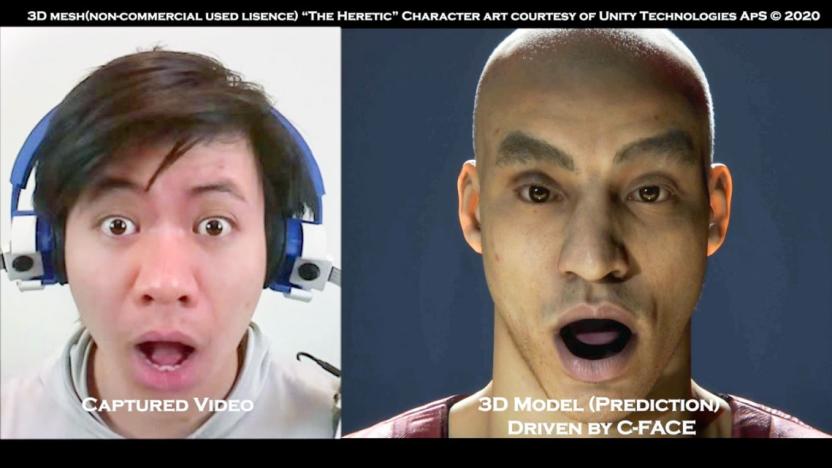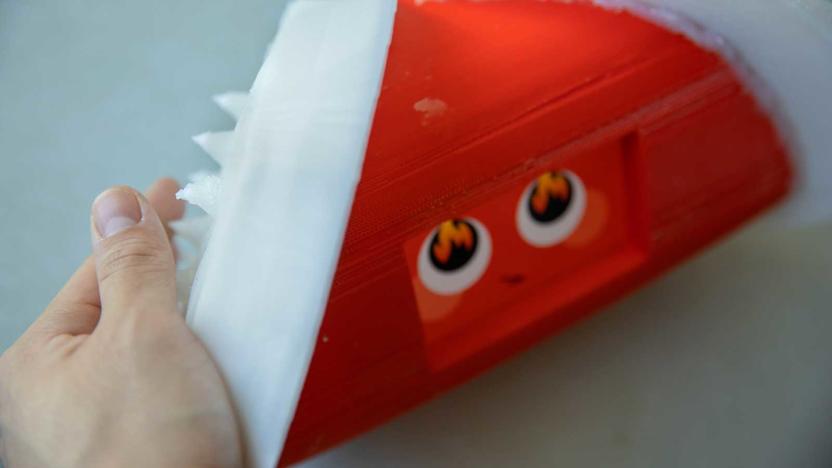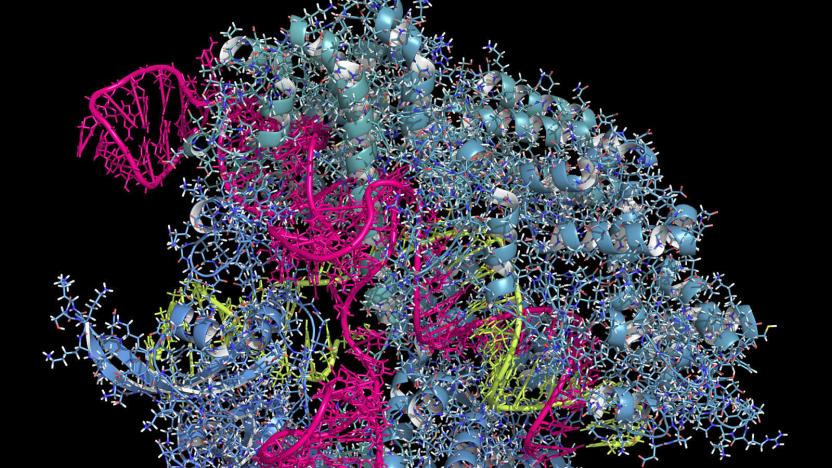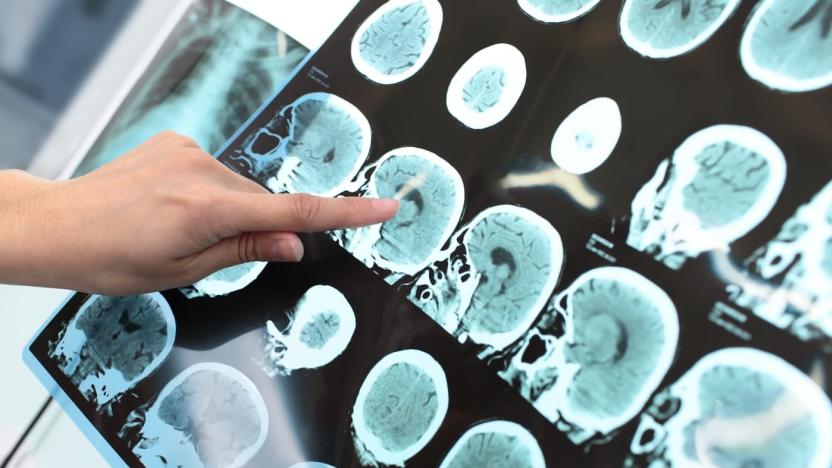cornelluniversity
Latest

Cornell researchers created an earphone that can track facial expressions
The team says C-Face works even when the subject is wearing a mask.

Emotional robot uses goosebumps to show how it's feeling
Sure, a robot can show how it's feeling (insofar as a robot can feel) with its face, but that's not the only way living beings do it. Humans have their goosebumps, for instance, while cats and dogs will raise their fur. Cornell wants to bring that nuance to synthetic beings. Its researchers have crafted a robot that uses a soft, adjustable skin to provide a tactile indication of a robot's emotion -- as the university put it, you can feel its feelings. It may develop goosebumps if it's happy, spikes if it's angry, or just a timid response if it's sad and needs a hug.

Atomic 'photos' help make gene editing safer
Believe it or not, scientists haven't had a close-up look at CRISPR gene editing. They've understood its general processes, but not the minutiae of what's going on -- and that raises the risk of unintended effects. They'll have a much better understanding going forward. Cornell and Harvard researchers have produced snapshots of the CRISPR-Cas3 gene editing subtype (not the Cas9 you normally hear about) at near atom-level resolution. They used a mix of cryo-electron microscopy and biochemistry to watch as a riboprotein complex captured DNA, priming the genes so the namesake Cas3 enzyme can start cutting. The team combined hundreds of thousands of particles into 2D averages of CRISPR's functional states (many of which haven't been seen before) and turned them into 3D projections you can see at the source link.

IBM-powered DNA sequencing could find bacteria in raw milk
Babies love milk. Adults love milk-based products. You know what else loves milk? Good and bad bacteria. It's the ideal medium for bacteria growth and could cause various food-borne illnesses, especially if consumed in raw, unpasteurized form. Researchers typically just test the milk supply in the US for specific pathogens or harmful bacteria and viruses, but IBM and Cornell University want to take things a step further. They plan to create new analytical tools that can monitor raw milk -- that's milk straight out of the udder -- and instantly detect any anomaly that could turn out to be a food safety hazard.

Robots could soon cooperate on surveillance
Computers are getting better at spotting objects, but they tend to work in isolation. What good would a security robot be if it couldn't share info about an intruder with other machines? Cornell scientists might have an answer. They're designing a system that would let robots and other autonomous devices cooperate with each other on identifying and tracking objects. Each bot would send its imagery to a central unit that could talk to both other camera systems and the internet to help identify objects. The group would combine and compare images to follow objects and collect more information about them, getting more data than they would if they did all the work by themselves.

ICYMI: Raining tiny satellites and the laundry-folding machine
Today on In Case You Missed It: A company called FoldiMate is selling a standalone machine to sit alongside a washing and dryer and fold about 20 garments at a time for $850. Cornell University engineers are sending tiny interstellar computers to the ISS this summer, there they will act as satellites and, eventually, collect information from our nearest neighboring star system, Alpha Centauri. We also round up the week in our TL; DR segment. If you grew up playing The Sims, this piece of news might interest you. We're also very interested in the Visa payment ring the Olympic athletes can wear in Rio. As always, please share any great tech or science videos you find by using the #ICYMI hashtag on Twitter for @mskerryd.

Cornell researchers create 3D printer that builds as you work
There's no denying the benefits of 3D printing for hobbyists and folks looking to prototype potential products. However, making changes typically means waiting for the current version to finish printing and starting a new build from scratch. Researchers at Cornell University are looking for a better solution that makes for easy tweaks and they've built "an interactive prototyping system" to do so. The "on-the-fly" 3D printing setup outputs the design that's being worked on as its created in a CAD file, allowing the user to pause for testing, measurements or to change the model that's still in progress.

Brain glucose levels can predict someone waking from a coma
Watching a loved one exist in a vegetative state can be absolutely heartbreaking, but there isn't a lot that can be done aside from waiting to see if they'll come out of it. A big problem is that doctors have a hard time discerning between patients in an unresponsive wakeful state (eyes open but their bodies physically unresponsive) and those who are in a minimally conscious state and sometimes respond to stimulus, as Stat writes. People suffering from the latter are more likely to regain consciousness. However, new research from Cornell University hopes to identify which patients might exit their unresponsive state and wake up.

Researchers develop passive-aggressive robotic roommate
While we've seen new robotic devices that can do everything from driving a car to thwarting underwater terrorists, a team of robotics researchers from Cornell and Stanford just want to make sure you never forget to put away the milk. At the International Conference on Robotics and Automation yesterday, the team presented Watch-Bot, a sort of robo-sentry that keeps an eye on the most mundane tasks in your home or office and politely shames you with a reminder if you forget to do them.

Ancient mega-tsunamis hint at cold Martian oceans
3.4 billion years ago, a meteorite smashed into the northern plains of Mars, where an ancient ocean once stood. Its impact threw up a massive wall of liquid water that scarred the surrounding landscape with backwash channels as the water poured back into the Martian sea. A few million years later, after the Red Planet had cooled significantly, another huge chunk of space rock tore into Mars -- however, this time, the resulting tsunami was made of ice blobs that simply stuck wherever they landed rather than return to the sea.

GPS top hat uses directional sound to show the way
Never mind pulling out your phone to get directions to the pub... how about some fine headwear? A team of Cornell University students has developed a GPS-enabled top hat that relies solely on directional sound for navigation. It uses a mix of amplitude and phase shifting to make it seem like audio cues are coming from the direction you're supposed to be going. The prototype may look ludicrous, but it's both hands-free and language-free -- you don't need to wait for instructions before turning down a side street.

Scientists confirm a cornerstone of quantum computing
Quantum physics theory has an odd but fundamental quirk: atoms in a quantum state aren't supposed to move as long as you're measuring them. It sounds preposterous, but Cornell University researchers have just demonstrated that it's real. The team noticed that the atoms in an extremely cold cloud of Rubidium gas wouldn't move around as long as they were under observation. The more often scientists used a laser to measure the behavior, the less movement they saw. They had to either tone the laser down or turn it off entirely for the atoms to shuffle around freely.

Scientists make an artificial heart out of foam
Artificial hearts only kinda-sorta behave like the real thing. They pump blood, sure, but they're typically solid blocks of machinery that are out of place in a squishy human body. Cornell University thinks it can do better, though: its scientists have developed an artificial foam heart that imitates both the functions and shape of its fleshy counterpart. The key is a new polymer that can be poured into specific shapes, and has pores that let it pump fluids. It's not only soft and stretchable, but more efficient -- you don't need much energy to get liquids moving.

Cornell's website can ID bird species through photos
Casual birdwatchers may want to bookmark Merlin Bird Photo ID, a website created by Cornell University and the Visipedia research project. Thanks to powerful artificial intelligence techniques, the website can identify birds in photos you upload, so long as they're species found in the US and Canada. You will need to draw a box around the feathered creature, click its beak, eye and tail, as well as identify where and when you took the picture. But after that, the system will do the rest: it will sift through the numerous photos taken by other birdwatchers, including the 70 million images in the eBird.org database, to find ones that match your image.

3-atom-thick transistor promises ultrathin electronics
Researchers from Cornell University announced a breakthrough in transistor technology in the latest issue of the journal, Nature. The team has reportedly developed a novel and highly efficient method of producing an experimental material known as transition metal dichalcogenide (TMD). TMD is an exceedingly thin (but highly conductive) film, which makes it useful in many high-tech applications -- everything from solar cells to flexible, wearable gadgets -- but also makes it a huge pain to produce in appreciable quantities. That is, until now.

Watch this soft robot walk through snow and get squished by a car
Soft robots aren't just supremely flexible; they can take quite a bruising, too. If you need proof, a team of Harvard and Cornell researchers has developed a rugged soft robot that can survive conditions which would wreck stiffer machines. As you'll see in the video below, the automaton's silicone shell has no trouble wading through snow, walking over fire and enduring the crush of a car's tires. It's a bit of a workhorse as well, with upgraded pneumatics that can carry loads up to about 18 pounds. This is still early technology -- the bot doesn't move quickly, and its battery lasts a mere two hours -- but it's proof that squishy robots are well-suited to working in dangerous situations.

Composite lighting technique lets amateurs produce well-lit photos in minutes (video)
Hobbyist photographers don't often have the luxury of elaborate lighting rigs. However, Adobe and Cornell University have developed a new software technique that could bring pro-grade illumination to a wider audience. Known as computational lighting design, the solution simplifies a familiar trick that combines shots taken with a camera's external flash placed in different positions. The software uses multiple sample photos to create composite images that emphasize color, edge lighting and fill lighting; editors just have to balance those three light values to get the desired effect. While the code is still unpolished, it's good enough that even beginners can produce well-lit masterpieces in less than 15 minutes. Adobe believes that the technique could reach future versions of apps like Lightroom or Photoshop, so don't be surprised if still-life photography catches on in the near future.

Eyes-on with Cornell University's laser tag dunebots (video)
Cornell University may be the host of the Cornell Cup competition, but that doesn't mean it can't bring its own robots to join in on the fun. This year, students brought along a few bots, dubbed dunebots, outfitted with all-terrain wheels and equipped with laser tag turrets. The rugged rig features a pair of cameras, a dustproof and water resistant chassis, air intakes capped with filters, and other components for suspension and steering. Not only does the team plan on releasing code and documentation for the project, but the hardware was designed with modularity in mind, so others can build their own modified versions. Taking the robot into battle requires two pilots armed with Xbox 360 controllers: one directing where it travels, and another aiming the turret and firing. Driving the buggy over the web is also possible, though it takes a few seconds for it to react. The group also baked in voice controls, to boot. If you're not watching the car duke it out in person, you can even tune in over the web and watch a live video stream from one of its onboard cams. Its top speeds haven't been firmly nailed down, but the team says the bot was running at approximately 35 percent of its full potential, since it was deemed too fast for conference attendees. Hit the jump to catch us talk with the effort's Computer Science lead Mike Dezube, and to see a dunebot in action.%Gallery-187525%

Cornell scientists 3D print ears with help from rat tails and cow ears
Science! A team of bioengineers and physicians over at Cornell University recently detailed their work to 3D print lifelike ears that may be used to treat birth defects like microtia and assist those who have lost or damaged an ear due to an accident or cancer. The product, which is, "practically identical to the human ear," according to the school, was created using 3D printing and gels made from living cells -- collagen was gathered from rat tails and cartilage cells were taken from cow's ears. The whole process is quite quick, according to associate professor Lawrence Bonassar, who co-authored the report on the matter, "It takes half a day to design the mold, a day or so to print it, 30 minutes to inject the gel, and we can remove the ear 15 minutes later. We trim the ear and then let it culture for several days in nourishing cell culture media before it is implanted." The team is looking to implant the first ear in around three years, if all goes well.

Researchers turn to 19th century math for wireless data center breakthrough
Researchers from Microsoft and Cornell University want to remove the tangles of cables from data centers. It's no small feat. With thousands of machines that need every bit of bandwidth available WiFi certainly isn't an option. To solve the issue, scientists are turning to two sources: the cutting edge of 60GHz networking and the 19th century mathematical theories of Arthur Cayley. Cayley's 1889 paper, On the Theory of Groups, was used to guide their method for connecting servers in the most efficient and fault tolerant way possible. The findings will be presented in a paper later this month, but it won't be clear how effectively this research can be applied to an actual data center until someone funds a prototype. The proposed Cayley data centers would rely on cylindrical server racks that have transceivers both inside and outside the tubes of machines, allowing them to pass data both among and between racks with (hopefully) minimal interference. Since the new design would do away with traditional network switches and cables, researchers believe they may eventually cost less than current designs and will draw less power. And will do so while still streaming data at 10 gigabits per second -- far faster than WiGig, which also makes use of 60GHz spectrum. To read the paper in its entirety check out the source.









